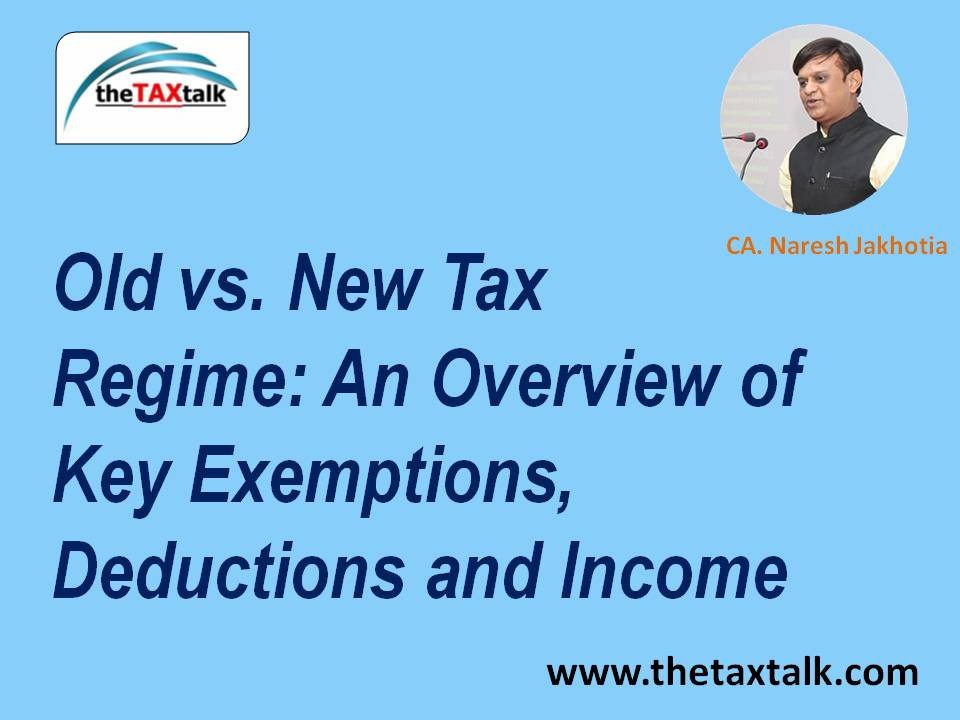![]()
Old vs. New Tax Regime: An Overview of Key Exemptions, Deductions and Income
The New Tax Regime (NTR) has now become the default tax regime. Taxpayers who wish to opt for the Old Tax Regime (OTR) must file Form 10IE before the due date if such person has income from Business & profession. Other taxpayers without business income need not file Form No. 10IE & can opt for OTR by exercising the option in the ITR form only. Despite its introduction in 2020, the NTR continues to cause confusion due to numerous amendments. Taxpayers are still grappling with the decision of choosing the right tax regime. Let’s take a brief look at the treatment of various incomes, deductions, and exemptions under the Old Tax Regime (OTR) compared to the New Tax Regime (NTR)
1. Capital Gain Income:
As far as Long Term Capital Gain (LTCG) is concerned, it is tax neutral & not at all dependent on the choice of OTR or the NTR. LTCG arising on sale of shares/equity mutual fund will still be taxable @10% on Capital gain above Rs. 1 Lakh.Further as far as Short Term Capital Gain (STCG) on sale of shares is concerned, it will continue to be taxable at a special rate of 15% irrespective of choice of tax regime. Similarly, exemption against LTCG would remain unaffected whether taxpayers opt for NTR or OTR.
2. Interest on PPF Account:
Interest on PPF is exempt from income tax whether you follow the OTR or the NTR.
3. House Rent Allowance (HRA):
One of the biggest deductions for the salaried taxpayers living in a rented premise is deduction towards HRA. The deduction towards HRA is admissible only if the taxpayer is opting for the OTR and not otherwise. The quantum of exemption allowable on HRA to meet expenditure on payment of rent shall be the least of the following:
a] The actual HRA amount received,
b] Rent paid in excess of 1/10thof the salary due for the relevant period; or
c] Where such accommodation is situated in Mumbai, Kolkata, Delhi or Chennai, 50% of the salary due to the employee for the relevant period; or Where such accommodation is situated in any other places, 40% of the salary due to the employee for the relevant period
[For this purpose, “Salary” includes dearness allowance, if the terms of employment so provide, but excludes all other allowances and perquisites].
4. Leave Travel Concessions (LTC):
LTC is the most common element of compensation adopted by employers to remunerate employees due to the tax benefits. LTC is eligible for tax exemption if the employer provides LTC to employees for travel to any place in India undertaken by the employees for himself & his family. It is exempt twice in a block of four years. Such exemption is limited to the extent of actual travel fare incurred by the employee. Travel has to be undertaken within India. Overseas destinations are not covered for exemption. This deduction is available only if the taxpayer is opting for OTR.
5. Benefit of Standard Deduction to Salaried Taxpayers:
Till FY 2022-23, the benefit of standard deduction was not available to the taxpayers opting for NTR. W.e.f. FY 2023-24, the benefit of standard deduction of Rs.50,000/-is available under both the regimes.
6. Deduction towards repayment of the Housing Loan:
For years, Housing loan has been offering the tax sops to the taxpayers in the form of deduction towards interest [up to a maximum of Rs. 2 Lakh U/s 24(b)] and principal repayment [up to a maximum of Rs. 1.50 Lakh U/s 80C]. The benefit of deduction is now restricted to only those taxpayers who opt for the OTR & not to those who wish to be in NTR. In my view, any taxpayers who are able to avail the benefit of a housing loan should check twice before opting for the NTR.
7. Deduction under Chapter VI-A:
Following deductions are available only if the taxpayer is opting for the OTR & not for the taxpayers under NTR:
a)Deduction up to Rs. 1.50 lakh under section 80C towards LIC, PFF, NSC, ELSS, etc.
b)Deduction up to Rs. 25,000/- (stretchable to Rs. 50,000/-) towards payment of mediclaim policy under section 80D.
c)Deduction of Rs. 50,000/- towards National Pension Scheme U/s 80CCD(1B).
d)Deduction towards medical treatment/maintenance of a dependent with disability of Rs. 75,000/- [Rs. 1,25,000/- for severe disability of 80% or more]under section 80DD.
e)Deduction up to Rs. 40,000/- [Rs 1,00,000 for resident senior citizen] towards specified medical treatment under section 80DDB.
f)Deduction (without any maximum cap) towards interest on education loan taken for the education of Self, Spouse or Children of Individual or for the student of whom individual is legal Guardian.
g)Deduction towards donation to certain relief funds and charitable institutions under section 80G.
h) 10,000/- saving bank account interest u/s 80TTA (Rs. 50,000/- by senior citizens u/s 80TTB)
Conclusion:
Before opting for any tax regime, taxpayers must calculate the total income tax under the OTR as well as NTR individually. If the benefits of exemptions and deductions outweigh the impact of a higher tax rate under the old regime, sticking to the old regime may be advisable. It makes sense to calculate the tax liability under both the regimes before taking a final call.
[Views expressed are the personal view of the author. Readers are advised to seek professional advice before taking any decisions. Readers may forward their feedback & queries at nareshjakhotia@gmail.com. Other articles & response to queries are available at www.theTAXtalk.com]

